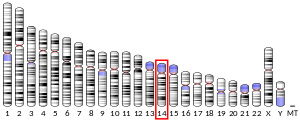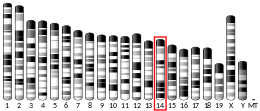Chromodomain-helicase-DNA-binding protein 8 is an enzyme that in humans is encoded by the CHD8 gene.[5][6]
Function
editThe gene CHD8 encodes the protein chromodomain helicase DNA binding protein 8,[7] which is a chromatin regulator enzyme that is essential during fetal development.[8] CHD8 is an ATP dependent enzyme.[9]
The protein contains an Snf2 helicase domain that is responsible for the hydrolysis of ATP to ADP.[9] CHD8 encodes for a DNA helicase that function as a transcription repressor by remodeling chromatin structure by altering the position of nucleosomes.[8] CHD8 negatively regulates Wnt signaling.[10] Wnt signaling is important in the vertebrate early development and morphogenesis. It is believed that CHD8 also recruits the linker histone H1 and causes the repression of β-catenin and p53 target genes.[7] The importance of CHD8 can be observed in studies where CHD8-knockout mice died after 5.5 embryonic days because of widespread p53 induced apoptosis.[7]
Recently CD8 has been associated to the regulation of long non-coding RNAs (lncRNAs),[11] and the regulation of X chromosome inactivation (XCI) initiation, via regulation of Xist long non-coding RNA, the master regulator of XCI, though competitive binding to Xist regulatory regions.[12]
Clinical significance
editMutations in this gene have been linked to a subset of autism[13] cases in human and mouse models.[14]
Mutations in CHD8 could lead to upregulation of β-catenin-regulated genes, in some part of the brain this upregulation can cause brain overgrowth also known as macrocephaly[8]
Some studies have determined the role of CHD8 in autism spectrum disorder (ASD).[8] CHD8 expression significantly increases during human mid-fetal development.[7] The chromatin remodeling activity and its interaction with transcriptional regulators have shown to play an important role in ASD aetiology.[15] The developing mammalian brain has a conserved CHD8 target regions that are associated with ASD risk genes.[8] The knockdown of CHD8 in human neural stem cells results in dysregulation of ASD risk genes that are targeted by CHD8.[16]
References
edit- ^ a b c GRCh38: Ensembl release 89: ENSG00000100888 – Ensembl, May 2017
- ^ a b c GRCm38: Ensembl release 89: ENSMUSG00000053754 – Ensembl, May 2017
- ^ "Human PubMed Reference:". National Center for Biotechnology Information, U.S. National Library of Medicine.
- ^ "Mouse PubMed Reference:". National Center for Biotechnology Information, U.S. National Library of Medicine.
- ^ Nagase T, Kikuno R, Nakayama M, Hirosawa M, Ohara O (August 2000). "Prediction of the coding sequences of unidentified human genes. XVIII. The complete sequences of 100 new cDNA clones from brain which code for large proteins in vitro". DNA Research. 7 (4): 273–81. doi:10.1093/dnares/7.4.271. PMID 10997877.
- ^ "Entrez Gene: CHD8 chromodomain helicase DNA binding protein 8".
- ^ a b c d Nishiyama M, Oshikawa K, Tsukada Y, Nakagawa T, Iemura S, Natsume T, et al. (February 2009). "CHD8 suppresses p53-mediated apoptosis through histone H1 recruitment during early embryogenesis". Nature Cell Biology. 11 (2): 172–82. doi:10.1038/ncb1831. PMC 3132516. PMID 19151705.
- ^ a b c d e Ronan JL, Wu W, Crabtree GR (May 2013). "From neural development to cognition: unexpected roles for chromatin". Nature Reviews. Genetics. 14 (5): 347–59. doi:10.1038/nrg3413. PMC 4010428. PMID 23568486.
- ^ a b Thompson BA, Tremblay V, Lin G, Bochar DA (June 2008). "CHD8 is an ATP-dependent chromatin remodeling factor that regulates beta-catenin target genes". Molecular and Cellular Biology. 28 (12): 3894–904. doi:10.1128/MCB.00322-08. PMC 2423111. PMID 18378692.
- ^ Nishiyama M, Skoultchi AI, Nakayama KI (January 2012). "Histone H1 recruitment by CHD8 is essential for suppression of the Wnt-β-catenin signaling pathway". Molecular and Cellular Biology. 32 (2): 501–12. doi:10.1128/MCB.06409-11. PMC 3255766. PMID 22083958.
- ^ Wilkinson B, Grepo N, Thompson BL, Kim J, Wang K, Evgrafov OV, et al. (May 2015). "The autism-associated gene chromodomain helicase DNA-binding protein 8 (CHD8) regulates noncoding RNAs and autism-related genes". Translational Psychiatry. 5 (5): e568. doi:10.1038/tp.2015.62. ISSN 2158-3188. PMC 4471293. PMID 25989142.
- ^ Cerase A, Young AN, Ruiz NB, Buness A, Sant GM, Arnold M, et al. (2021-04-15). "Chd8 regulates X chromosome inactivation in mouse through fine-tuning control of Xist expression". Communications Biology. 4 (1): 485. doi:10.1038/s42003-021-01945-1. ISSN 2399-3642. PMC 8050208. PMID 33859315.
- ^ Bernier R, Golzio C, Xiong B, Stessman HA, Coe BP, Penn O, et al. (July 2014). "Disruptive CHD8 mutations define a subtype of autism early in development". Cell. 158 (2): 263–276. doi:10.1016/j.cell.2014.06.017. PMC 4136921. PMID 24998929.
- ^ Gompers AL, Su-Feher L, Ellegood J, Copping NA, Riyadh MA, Stradleigh TW, et al. (August 2017). "Germline Chd8 haploinsufficiency alters brain development in mouse". Nature Neuroscience. 20 (8): 1062–1073. doi:10.1038/nn.4592. OSTI 1436635. PMC 6008102. PMID 28671691.
- ^ Sugathan A, Biagioli M, Golzio C, Erdin S, Blumenthal I, Manavalan P, et al. (October 2014). "CHD8 regulates neurodevelopmental pathways associated with autism spectrum disorder in neural progenitors". Proceedings of the National Academy of Sciences of the United States of America. 111 (42): E4468-77. Bibcode:2014PNAS..111E4468S. doi:10.1073/pnas.1405266111. PMC 4210312. PMID 25294932.
- ^ Cotney J, Muhle RA, Sanders SJ, Liu L, Willsey AJ, Niu W, et al. (March 2015). "The autism-associated chromatin modifier CHD8 regulates other autism risk genes during human neurodevelopment". Nature Communications. 6 (6): 6404. Bibcode:2015NatCo...6.6404C. doi:10.1038/ncomms7404. PMC 4355952. PMID 25752243.
External links
editFurther reading
edit- Nakajima D, Okazaki N, Yamakawa H, Kikuno R, Ohara O, Nagase T (June 2002). "Construction of expression-ready cDNA clones for KIAA genes: manual curation of 330 KIAA cDNA clones". DNA Research. 9 (3): 99–106. doi:10.1093/dnares/9.3.99. PMID 12168954.
- Epplen C, Epplen JT (January 1994). "Expression of (cac)n/(gtg)n simple repetitive sequences in mRNA of human lymphocytes". Human Genetics. 93 (1): 35–41. doi:10.1007/BF00218910. PMID 7505766. S2CID 22998633.
- Sakamoto I, Kishida S, Fukui A, Kishida M, Yamamoto H, Hino S, et al. (October 2000). "A novel beta-catenin-binding protein inhibits beta-catenin-dependent Tcf activation and axis formation". The Journal of Biological Chemistry. 275 (42): 32871–8. doi:10.1074/jbc.M004089200. PMID 10921920.
- Kobayashi M, Hanai R (September 2001). "M phase-specific association of human topoisomerase IIIbeta with chromosomes". Biochemical and Biophysical Research Communications. 287 (1): 282–7. doi:10.1006/bbrc.2001.5580. PMID 11549288.
- Kobayashi M, Kishida S, Fukui A, Michiue T, Miyamoto Y, Okamoto T, et al. (February 2002). "Nuclear localization of Duplin, a beta-catenin-binding protein, is essential for its inhibitory activity on the Wnt signaling pathway". The Journal of Biological Chemistry. 277 (8): 5816–22. doi:10.1074/jbc.M108433200. PMID 11744694.
- Nishiyama M, Nakayama K, Tsunematsu R, Tsukiyama T, Kikuchi A, Nakayama KI (October 2004). "Early embryonic death in mice lacking the beta-catenin-binding protein Duplin". Molecular and Cellular Biology. 24 (19): 8386–94. doi:10.1128/MCB.24.19.8386-8394.2004. PMC 516734. PMID 15367660.
- Lin KT, Lu RM, Tarn WY (October 2004). "The WW domain-containing proteins interact with the early spliceosome and participate in pre-mRNA splicing in vivo". Molecular and Cellular Biology. 24 (20): 9176–85. doi:10.1128/MCB.24.20.9176-9185.2004. PMC 517884. PMID 15456888.
- Ishihara K, Oshimura M, Nakao M (September 2006). "CTCF-dependent chromatin insulator is linked to epigenetic remodeling". Molecular Cell. 23 (5): 733–42. doi:10.1016/j.molcel.2006.08.008. PMID 16949368.
- Beausoleil SA, Villén J, Gerber SA, Rush J, Gygi SP (October 2006). "A probability-based approach for high-throughput protein phosphorylation analysis and site localization". Nature Biotechnology. 24 (10): 1285–92. doi:10.1038/nbt1240. PMID 16964243. S2CID 14294292.
- Olsen JV, Blagoev B, Gnad F, Macek B, Kumar C, Mortensen P, et al. (November 2006). "Global, in vivo, and site-specific phosphorylation dynamics in signaling networks". Cell. 127 (3): 635–48. doi:10.1016/j.cell.2006.09.026. PMID 17081983.
- Yuan CC, Zhao X, Florens L, Swanson SK, Washburn MP, Hernandez N (December 2007). "CHD8 associates with human Staf and contributes to efficient U6 RNA polymerase III transcription". Molecular and Cellular Biology. 27 (24): 8729–38. doi:10.1128/MCB.00846-07. PMC 2169411. PMID 17938208.
- Thompson BA, Tremblay V, Lin G, Bochar DA (June 2008). "CHD8 is an ATP-dependent chromatin remodeling factor that regulates beta-catenin target genes". Molecular and Cellular Biology. 28 (12): 3894–904. doi:10.1128/MCB.00322-08. PMC 2423111. PMID 18378692.
- Caldon CE, Sergio CM, Schütte J, Boersma MN, Sutherland RL, Carroll JS, et al. (September 2009). "Estrogen regulation of cyclin E2 requires cyclin D1 but not c-Myc". Molecular and Cellular Biology. 29 (17): 4623–39. doi:10.1128/MCB.00269-09. PMC 2725719. PMID 19564413.
- Nishiyama M, Oshikawa K, Tsukada Y, Nakagawa T, Iemura S, Natsume T, et al. (February 2009). "CHD8 suppresses p53-mediated apoptosis through histone H1 recruitment during early embryogenesis". Nature Cell Biology. 11 (2): 172–82. doi:10.1038/ncb1831. PMC 3132516. PMID 19151705.
- Rodríguez-Paredes M, Ceballos-Chávez M, Esteller M, García-Domínguez M, Reyes JC (May 2009). "The chromatin remodeling factor CHD8 interacts with elongating RNA polymerase II and controls expression of the cyclin E2 gene". Nucleic Acids Research. 37 (8): 2449–60. doi:10.1093/nar/gkp101. PMC 2677868. PMID 19255092.
- Yates JA, Menon T, Thompson BA, Bochar DA (February 2010). "Regulation of HOXA2 gene expression by the ATP-dependent chromatin remodeling enzyme CHD8" (PDF). FEBS Letters. 584 (4): 689–93. doi:10.1016/j.febslet.2010.01.022. hdl:2027.42/116349. PMID 20085832. S2CID 9956275.





